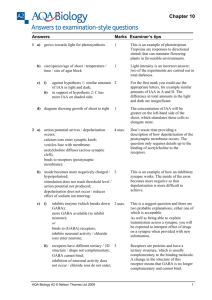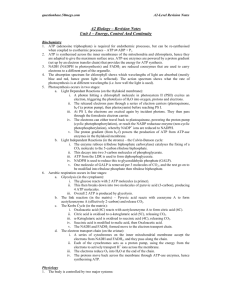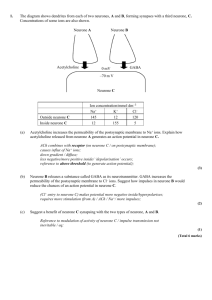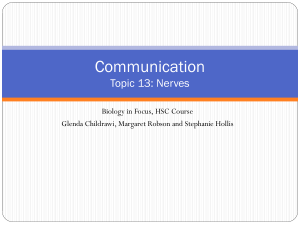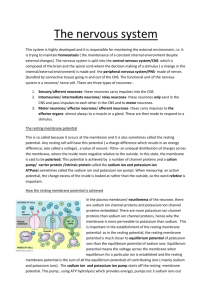14.1.1 Tranismission of Signals
advertisement
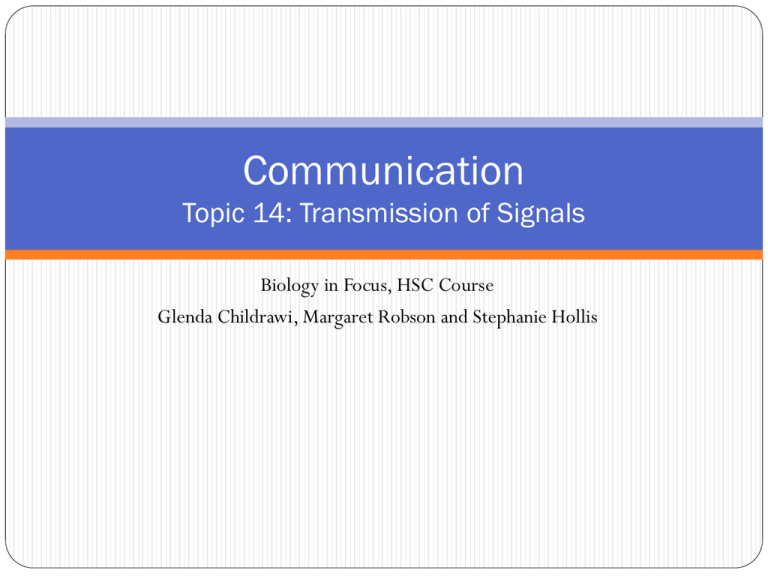
Communication Topic 14: Transmission of Signals Biology in Focus, HSC Course Glenda Childrawi, Margaret Robson and Stephanie Hollis DOT Point(s) identify neurones as nerve cells that are the transmitters of signals by electro-chemical changes in their membranes present information from secondary sources to graphically represent a typical action potential define the term ‘threshold’ and explain why not all stimuli generate an action potential Introduction Signals are transmitted by nerves in the form of electricity along the neuronal membrane, and by chemicals from one neurone to the next. This is why its called an electrochemical change. howtoimprovemybrain.info Neurones Contain Ions Nerve impulses are electrical signals which are produced by the plasma membrane (cell membrane) of the nerve cell. The human body as a whole is electrically neutral, having almost the same number of positive charges as negative charges. www.vce.bioninja.com.au Neurones Contain Ions It may help to think of a torch and how it works. Its battery separates electrical charges between two poles, the positive and the negative. This gives the two charges potential energy. The measure of this potential energy is called voltage. cnx.org Neurones Contain Ions Voltage is always measured between two points and is called potential difference or simply potential. The flow of electricity from one point to another is called a current and it can be made to do work. www.creativesafetysupply.com Neurones Contain Ions A potential difference exists across every cell’s plasma membrane. The side of the membrane exposed to the cytoplasm is negative while the side exposed to the extracellular fluid is positive. best-diving.org Neurones Contain Ions The differences on either side of the membrane result in a cellular voltage, which is called the resting membrane potential and measures about 70 millivoilts. It is written as -70mV, which indicates that the inside of the membrane is negative. The membrane is then said to be polarised. best-diving.org Neurones Contain Ions This arises because neurones contain ions (charged particles). Positively charged ions are called cations. Negative charged ions are called anions. When either of these is found in a solution, the solution is then an electrolyte solution. The cytoplasm of a cell and the extracellular fluid are both electrolyte solutions, but they differ greatly from each other. best-diving.org Neurones Contain Ions Cell membranes are impermeable to proteins and most organic phosphates, so these are kept inside the cytoplasm. The membranes are selectively permeable to Na+, K+ and Cl- because of ion channels. best-diving.org Neurones Contain Ions When the ion channel pores are open, ions can move from one side of the membrane to the other. Each channel allows only a specific type of ion to diffuse through it. best-diving.org Depolarisation and Action Potential Changes in the environment of a neurone can affect the permeability of the plasma membrane to ions and therefore change the membrane’s potential. Any environmental factor which causes such a change is called a stimulus and neurones are highly reactive to stimuli. best-diving.org Depolarisation and Action Potential A cell’s membrane potential can change in response to appropriate stimulation. A positive shift in membrane potential, from -70mV to 10mV, for example, is called a depolarisation. If the depolarisation is strong enough, this flow of ions causes the neurone to generate a nerve impulse or action potential. best-diving.org Depolarisation and Action Potential The action potentials are transmitted from neurone to neurone across small gaps called synapses (the junctions between the end of one axon and the dendrites of the cell body of a receiving neurone). The movement is in one direction only. best-diving.org Depolarisation and Action Potential At the synapse, chemicals known as neurotransmitters diffuse across the gap from one neurone to the membrane of the receiving neurone, causing an electrical response. best-diving.org Depolarisation and Action Potential The threshold is the amount of positive change in membrane potential which is required before an action potential is produced. The depolarisation must reach a threshold, which is at least 15mV more positive than the resting potential of 70mV. best-diving.org Depolarisation and Action Potential No action potential is produced if the depolarisation is below this level. This is one of the reasons why not all stimuli generate an action potential. Also, Each stimuli produces either a full action potential or none at all. Each action potential is a separate event. Therefore, a cell cannot produce another action potential until the previous one is complete. best-diving.org Activity -Handout Table 7.3 Typical changes in membrane potential -Handout DOT Point 7.8 Typical Action Potential -Students to create a graph to convey information in table.
